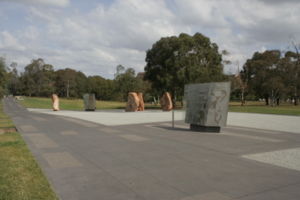
Reconciliation Place
Encyclopedia

Canberra
Canberra is the capital city of Australia. With a population of over 345,000, it is Australia's largest inland city and the eighth-largest city overall. The city is located at the northern end of the Australian Capital Territory , south-west of Sydney, and north-east of Melbourne...
, Australia
Australia
Australia , officially the Commonwealth of Australia, is a country in the Southern Hemisphere comprising the mainland of the Australian continent, the island of Tasmania, and numerous smaller islands in the Indian and Pacific Oceans. It is the world's sixth-largest country by total area...
, commenced in 2001 as a monument to reconciliation between Australia’s Indigenous people
Indigenous Australians
Indigenous Australians are the original inhabitants of the Australian continent and nearby islands. The Aboriginal Indigenous Australians migrated from the Indian continent around 75,000 to 100,000 years ago....
and settler population.
The design was selected by a national design competition in 2001 run by the National Capital Authority with a jury including Ian Spicer, Matilda House, and RAIA Gold Medal architect Ric Leplastrier. The winning entry was designed by architect Simon Kringas. Sharon Payne was Indigenous Cultural Advisor.
The design is dominated by a convex mound in the landscape centred on Walter Burley Griffin
Walter Burley Griffin
Walter Burley Griffin was an American architect and landscape architect, who is best known for his role in designing Canberra, Australia's capital city...
's land and water axes, establishing a subtle presence while maintaining the overwhelming passage of the land axis and views to the lake from the steps of Old Parliament House.
Linking the Australian High Court and the National Library of Australia
National Library of Australia
The National Library of Australia is the largest reference library of Australia, responsible under the terms of the National Library Act for "maintaining and developing a national collection of library material, including a comprehensive collection of library material relating to Australia and the...
is a public promenade with artworks called "Slivers" displaying images and text on various themes of reconciliation including:
- A welcome to NgunnawalNgunnawal peopleThe Ngunnawal people are the Indigenous Australian inhabitants whose traditional lands encompass much of the area now occupied by the city of Canberra, Australia and the surrounding Australian Capital Territory...
country - an acknowledgment of the traditional owners of the land on which Reconciliation Place is being built - The 1967 referendumAustralian referendum, 1967 (Aboriginals)The referendum of 27 May 1967 approved two amendments to the Australian constitution relating to Indigenous Australians. Technically it was a vote on the Constitution Alteration 1967, which became law on 10 August 1967 following the results of the referendum...
that amended the Australian constitution to allow the Commonwealth Government to legislate on Aboriginal and Torres Strait IslanderIndigenous AustraliansIndigenous Australians are the original inhabitants of the Australian continent and nearby islands. The Aboriginal Indigenous Australians migrated from the Indian continent around 75,000 to 100,000 years ago....
issues - The recognition of native titleNative titleNative title is the Australian version of the common law doctrine of aboriginal title.Native title is "the recognition by Australian law that some Indigenous people have rights and interests to their land that come from their traditional laws and customs"...
rights which found that native title to land was part of Australia's common law - The contribution Indigenous people have made, and continue to make, to Australia in sport and in the defence of our nation
- Indigenous leadership, depicting two great leaders — Neville BonnerNeville BonnerNeville Thomas Bonner AO was an Australian politician, and the first indigenous Australian to become a member of the Parliament of Australia...
and Vincent LingiariVincent LingiariVincent Lingiarri, AM , was an Aboriginal rights activist who was appointed as a Member of the Order of Australia for his services to the Aboriginal people. Lingiarri was a member of the Gurindji people. In Vincent's earlier life he worked as a stockman at Wave Hill Cattle Station. He also played...
and - The past practice of separating Indigenous children from their familiesStolen GenerationThe Stolen Generations were the children of Australian Aboriginal and Torres Strait Islander descent who were removed from their families by the Australian Federal and State government agencies and church missions, under acts of their respective parliaments...
.
The promenade is intended to evolve over time with the addition of new artworks.
The construction of Reconciliation Place was subject to a budget of only $3.5M, a limited timeframe (4 months for design and construction) and bureaucratic changes to the design. The intended geometric relationship to the neighbouring Commonwealth Place was not realised. It proposed that the Commonwealth Place ramp grade be marginally raised to join tangentially to the Reconciliation Place mound. After some delay this was supported by the Commonwealth Place designers but was then refused by the National Capital Authority. The ramp grade now terminates into the side of the mound.
Similarly, precisely cut stone walls inscribing the pathways around the mound were replaced by earth berms, and recently installed 'Slivers' bear no relationship to the original design concept, resulting in a loss of coherence.
Despite the shortcomings in the relationship between Reconciliation Place and Commonwealth Place, Vernon maintains

